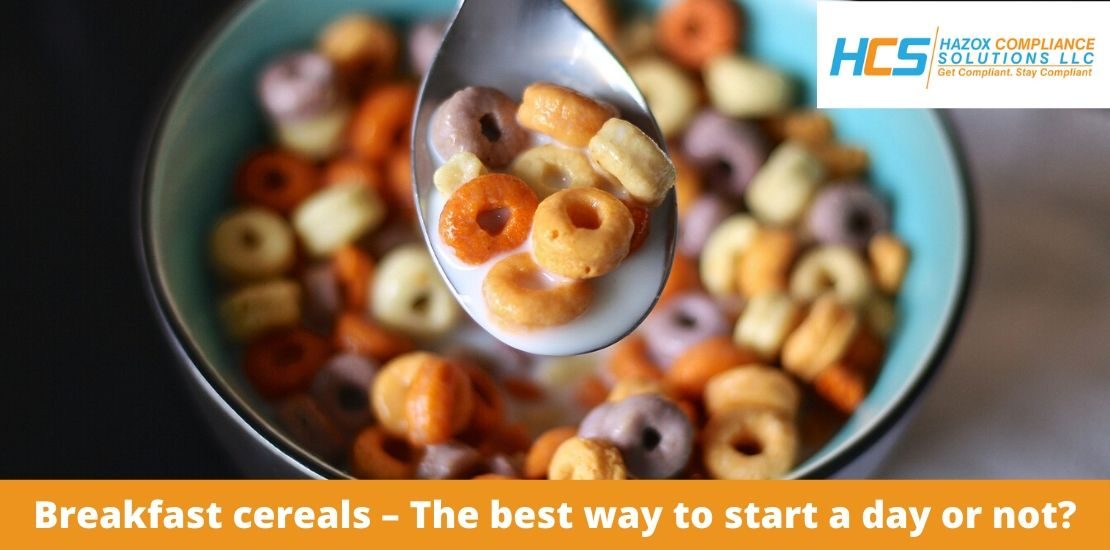- February 25, 2020
- Posted by: admin
- Category: Blogs

Most people have a favorite breakfast cereal that they like to eat in the morning or snack on throughout the day. Due to the manufacturing process, cereals contain varying amounts of acrylamide which form during the baking process from the natural chemical reaction between sugars and asparagine. (You can read about asparagine here https://www.hazoxinc.com/cookies-hazardous-to-your-health-in-ways-you-wouldnt-think-about/)
All of the major grains used in breakfast cereals form acrylamide, but in their survey on food, the U.S. Food and Drug Administration (FDA) found that some cereals yield much more than others, and in some cases as much as 14 times more (https://www.fda.gov/food/chemicals/survey-data-acrylamide-food) .
As we have already seen in our last article (https://www.hazoxinc.com/acrylamide-in-our-bagels/), acrylamide can affect our health in several ways. In this article we will look further at the health effects of acrylamide, more specifically at whether it can cause cancer.
We, at Hazox, have created a campaign to let you know of harmful chemicals in your food that you may not be aware of.
In the first issue, we looked at what acrylamide is. If you missed the first of the series, you can catch up here https://www.hazoxinc.com/potato-chips-contain-harmful-chemicals-that-you-may-not-know-about/.
The second article looked at the range of foods that acrylamide can be found in, you can find this article herehttps://www.hazoxinc.com/pretzels-contain-harmful-chemicals-that-you-may-not-know-about/.
Ou rnext article looked at how acrylamide is formed in our foods and how the different cooking methods affect the amount of acrylamide formed. Find it at https://www.hazoxinc.com/cookies-hazardous-to-your-health-in-ways-you-wouldnt-think-about/
In the fourth article in the series, we looked at other sources of acrylamide besides food. You will find this article herehttps://www.hazoxinc.com/finally-the-weekend-is-here-its-time-to-sit-back-and-relax-with-that-cup-of-coffee-but-do-we-know-whats-really-in-it/
Does acrylamide cause cancer?
Cancer is the second leading cause of death in the United States, and the number of cases is expected to continue to increase worldwide. Cancer prevention strategies are crucial to reducing the cancer burden.
Since the discovery of acrylamide in food in 2002, several studies have explored its potential as a human carcinogen. Most of these, however, did not report any statistically significant association between dietary acrylamide intake and various types of cancer, and few studies reported an increased risk of renal, endometrial and ovarian cancer. Besides this, exposure assessments have been inadequate, leading to possible misclassification or underestimation of the exposure effects.
With the information currently available, this is what several leading government agencies have to say on the subject.
- The International Agency for Research on Cancer (IARC) classifies acrylamide as a “probable human carcinogen”.
- The U.S. National Toxicology Program (NTP) has classified acrylamide as “reasonably anticipated to be a human carcinogen.
- The U.S. Environmental Protection Agency (EPA) classifies acrylamide as “probably carcinogenic to humans.
- The U.S. Food and Drug Administration (FDA) issued a consumer warning about acrylamide to limit exposure based on its carcinogenicity in animals.
- Similarly, based on animal studies, the National Toxicology Program (NTP) concluded in its 2011 Carcinogen Report that “acrylamide is reasonably expected to be a human carcinogen.
Although animal studies have found evidence that high levels of acrylamide are linked to the development of cancer, it is still not clear how these results apply to humans. Since the discovery of acrylamide in food, the American Cancer Society, the U.S. Food and Drug Administration (FDA), the World Health Organization (WHO), the European Food Safety Authority (EFSA), and many other organizations have recognized the need for further research on this topic. So far, reviews of studies conducted in epidemiological studies suggest that dietary acrylamide is unlikely to be associated with risk for the most common types of cancer. However, ongoing studies will continue to provide new information on whether acrylamide levels in foods are associated with increased cancer risk.
In our next article, on Wednesday, we will look at what the safe amount of acrylamide is in our food.
On Thursday we will look at how the body breaks down and disposes of acrylamide.
On Friday, the article will show you how you can detox from the acrylamide in your body.
On Saturday, we will review ways on protecting ourselves from acrylamides.
In our final article, on Sunday, we will investigate healthy alternatives to foods containing acrylamide.
If you liked our article, please share it, give us a Like and follow us on:
Facebook: https://www.facebook.com/HazoxComplianceSolutions
Twitter https://twitter.com/Hazox_Inc
LinkedIn https://www.linkedin.com/company/hazoxcompliancesolutions
Youtube: https://www.youtube.com/channel/UCIeBucyOUEtQFSAymS3TwQQ
